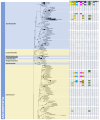Linking the Metabolic Activity of Plastic-Degrading Fungi to Their Taxonomy and Evolution
- PMID: 40422712
- PMCID: PMC12113260
- DOI: 10.3390/jof11050378
Linking the Metabolic Activity of Plastic-Degrading Fungi to Their Taxonomy and Evolution
Abstract
Plastic, a ubiquitous part of our daily lives, has become a global necessity, with annual production exceeding 300 million tons. However, the accumulation of synthetic polymers in our environment poses a pressing global challenge. To address this urgent issue, fungi have emerged as potential agents for plastic degradation. In our previous manuscript, 'A Review of the Fungi That Degrade Plastic', we explored the taxonomic placement of plastic-degrading fungi across three main phyla: Ascomycota, Basidiomycota, and Mucoromycota. In this review, we built upon that foundation and aimed to further explore the taxonomic relationships of these fungi in a comprehensive and detailed manner, leaving no stone unturned. Moreover, we linked metabolic activity and enzyme production of plastic-degrading fungi to their taxonomy and summarized a phylogenetic tree and a detailed table on enzyme production of plastic-degrading fungi presented here. Microbial enzymes are key players in polymer degradation, operating intra-cellularly and extra-cellularly. Fungi, one of the well-studied groups of microbes with respect to plastic degradation, are at the forefront of addressing the global issue of plastic accumulation. Their unique ability to hydrolyze synthetic plastic polymers and produce a wide range of specific enzymes is a testament to their potential. In this review, we gather and synthesize information concerning the metabolic pathways of fungi involved in the degradation of plastics. The manuscript explores the diverse range of specific enzymes that fungi can produce for plastic degradation and the major pathways of plastic metabolism. We provide a listing of 14 fungal enzymes (Esterase, Cutinase, Laccase, Peroxidases, Manganese peroxidase, Lignin peroxidase, Oxidoreductases, Urease, Protease, Lipase, Polyesterase, Dehydrogenase, Serine hydrolase, and PETase) involved in pathways for plastic degradation alongside the relevant fungi known to produce these enzymes. Furthermore, we integrate the fungi's enzyme-producing capabilities with their taxonomy and phylogeny. Taxonomic and phylogenetic investigations have pinpointed three primary fungal classes (Eurotiomycetes, Sordariomycetes (Ascomycota), and Agaricomycetes (Basidiomycota)) as significant plastic degraders that produce the vital enzymes mentioned earlier. This paper provides a foundational resource for recognizing fungal involvement in the biodegradation of synthetic polymers. It will ultimately advance fungal biotechnology efforts to address the global issue of plastic accumulation in natural environments.
Keywords: depolymerization; energy source; enzymes; metabolic by-products; mineralization.
Conflict of interest statement
The authors declare no conflicts of interest.
Figures


Similar articles
-
A Review of the Fungi That Degrade Plastic.J Fungi (Basel). 2022 Jul 25;8(8):772. doi: 10.3390/jof8080772. J Fungi (Basel). 2022. PMID: 35893140 Free PMC article. Review.
-
Metagenomic investigations into the microbial consortia, degradation pathways, and enzyme systems involved in the biodegradation of plastics in a tropical lentic pond sediment.World J Microbiol Biotechnol. 2024 Apr 17;40(6):172. doi: 10.1007/s11274-024-03972-6. World J Microbiol Biotechnol. 2024. PMID: 38630153
-
Harnessing the potential of white rot fungi and ligninolytic enzymes for efficient textile dye degradation: A comprehensive review.Water Environ Res. 2024 Jan;96(1):e10959. doi: 10.1002/wer.10959. Water Environ Res. 2024. PMID: 38204323 Review.
-
Insights into lignin degradation and its potential industrial applications.Adv Appl Microbiol. 2013;82:1-28. doi: 10.1016/B978-0-12-407679-2.00001-6. Adv Appl Microbiol. 2013. PMID: 23415151
-
Oxic and Anoxic Organic Polymer Degradation Potential of Endophytic Fungi From the Marine Macroalga, Ecklonia radiata.Front Microbiol. 2021 Oct 18;12:726138. doi: 10.3389/fmicb.2021.726138. eCollection 2021. Front Microbiol. 2021. PMID: 34733248 Free PMC article.
References
-
- Elahi A., Bukhari D.A., Shamim S., Rehman A. Plastics degradation by microbes: A sustainable approach. J. King Saud Univ. Sci. 2021;33:101538. doi: 10.1016/j.jksus.2021.101538. - DOI
-
- Statista Statista: Global No.1 Business Data Platform. 2022. [(accessed on 31 July 2024)]. Available online: https://www.statista.com.
-
- PlasticsEurope Plastics—The Facts 2020. An Analysis of European Plastics Production, Demand and Waste Data. 2020. [(accessed on 31 July 2024)]. Available online: https://issuu.com/plasticseuropeebook/docs/plastics_the_facts-web-dec2020.
Publication types
Grants and funding
LinkOut - more resources
Full Text Sources

